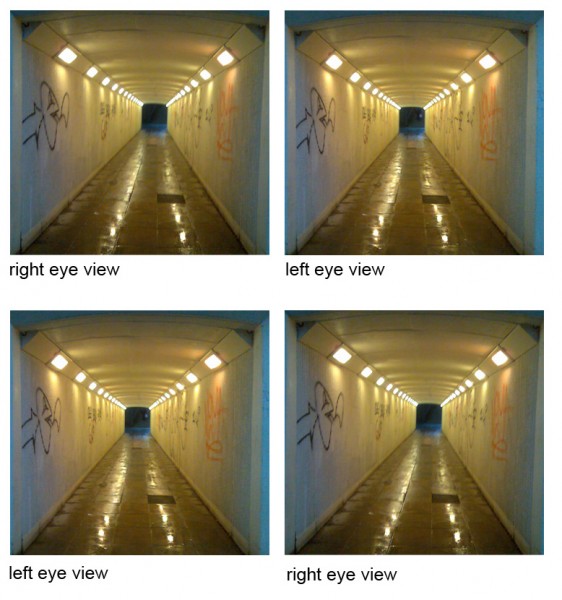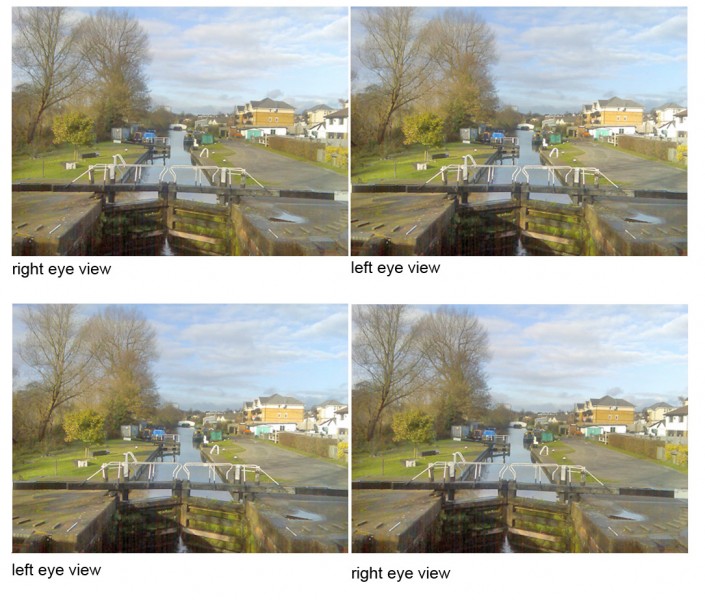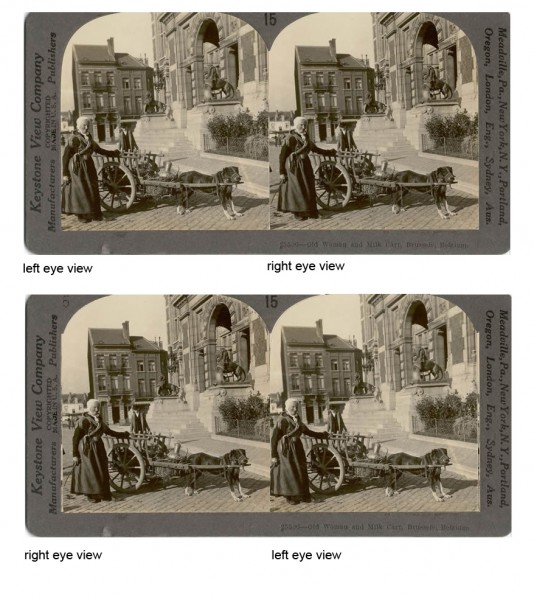We all know why stereo picture pairs give rise to a vivid illusion of 3D, don’t we? It’s because they imitate the way that our brains, if we are lucky enough to have normal vision, take advantage of the slight differences in viewpoint from our two eyes. We grow up hard wired with brain cells that look out for similarities in patches in the field of view of each eye that are just slightly displaced from one another. So if you rewired the brain, so that the left eye sees what the the right eye should, and vice versa, you’d see all the depth effects reversed, wouldn’t you? Well, no, in fact, not necessarily. Look at these picture pairs of a canal lock, near where I live, just north of London in the UK.
If you haven’t yet aquired the knack of viewing stereo picture pairs without a viewer, try this tutorial. You’ll easily find other guides by searching on “viewing 3d pictures” and similar phrases.
These pairs show a scene with the viewpoint from right and left preserved (lower pair) and reversed (upper pair). And yet both pairs give (for me) a fairly normal illusion of depth. One pair works better than the other. Usually, when viewing stereo picture pairs without a special viewer, the arrangement as in the upper pair above works best. (More on that below). So which pair looks better can depend on which technique you have used to view the pictures. But the fact that both pairs give an illusion of depth at all is remarkable.
It’s remarkable because reversing left and right picture pairs can result in the reversal of depth effects! Try these pairs. Forget, to start with, which is the left and which the right eye view. Just note that left and right images, as seen in the top pair, have changed places in the lower pair:
I find that I tend to see the top pair as if I were looking down a tube, and the lower pair as if I were looking down on a cone with the point sliced off, but with the more pointed end nearest to me. I can make myself see the top pair reversed, as a cone, and the bottom pair as a tube, but only with an effort.
Now the first thing to explain is that you’ll only see the images of the tube and cone the way I have described if you have used the technique for fusing the two pictures without a special viewer, which is called cross-eyed viewing. It’s the way most people find easiest. It’s equivalent to focussing on a point in front of the images, so that the two images seem to become four, and then fusing the middle two images and bringing them into focus. That in turn is equivalent to making the left eye see the right eye view and vice versa. It’s usual therefore for left and right eye views to be exchanged on the page, when pictures are presented for viewing without a viewer, (for example in scientific reports). But just to keep it complicated, there are people who can view picture pairs, without a viewer, in what is called wall eye viewing, as if focussing on a point behind the images, and then fusing them. They need right and left views to be preserved on the page. I for one haven’t got that knack. Left and right are also preserved in picture pairs prepared for viewing with a stereo viewer, of the kind invented by Victorian scientists Charles Wheatstone and David Brewster. That’s because the viewing devices used mirrors or prisms so that it becomes easy to view the picture pairs in wall-eyed mode, with right and left preserved. (Or rather, that’s what most viewing devices did. Once again, just in case you thought it was getting clearer, Wheatstone also invented a viewer that intentionally reversed left and right eye views, to explore the reversal effects. It’s called the Pseudoscope).
But then we come to the important point. Why does seeing the picture pairs exchanged reverse the perception of depth with the diagrammatic images of the tube and cone, but not reverse depth in the canal view? The short answer is that our knowledge and expectation about depth in the view of the canal override the highly improbable spatial effects we would see in a reversed depth interpretation of the scene. With the tube and cone, either view is equally probable.
But there’s more to it than that. Let’s look at the differences in the quality of the photo 3D views, with and without the left and right images reversed on the page. Consider a rather less attractive view near where I live, but a good one for thinking about 3D pictures.
 When I view the top picture pair in cross-eyed mode, I see the whole scene in vivid and consistent 3D. But now look at the dark paving tile, about four tiles up from the bottom and slightly right of centre in each image. Note that it is not reflective and so interrupts the line of bright reflections of the lights. When I view the bottom pair of pictures in 3D I find there’s something not quite right about the junction of the bright reflection and the dark tile. The reflection looks nearer to me than the tile. It should appear, as it does for me in the top pair of images, like a reflection in a mirror, as if behind the reflecting surface, not in front of it.
When I view the top picture pair in cross-eyed mode, I see the whole scene in vivid and consistent 3D. But now look at the dark paving tile, about four tiles up from the bottom and slightly right of centre in each image. Note that it is not reflective and so interrupts the line of bright reflections of the lights. When I view the bottom pair of pictures in 3D I find there’s something not quite right about the junction of the bright reflection and the dark tile. The reflection looks nearer to me than the tile. It should appear, as it does for me in the top pair of images, like a reflection in a mirror, as if behind the reflecting surface, not in front of it.
Let’s try another picture pair, this time a 19th century stereo photos of a scene in Brussels.
Note in these two picture pairs the dark door in the background, just in between the man and woman, and above the woman’s outstretched arm. For me, in the upper pair seen in 3D, that dark doorway and the patch of pale roadway under it seem to come forward, in front of the woman’s arm, though the scene as a whole looks not to bad. The lower picture pair is arranged for optimal viewing without a viewing device, and works much better for me. The door looks distant, as it should.
Here’s the important point, The bits of these scenes that seem spatially displaced when the images are presented with right and left eye views preserved, and so not optimally arranged for cross-eyed viewing, seem all to be high contrast edges – between the paving stone and the bright reflection in the underpass, and the door, roadway and woman’s sleeve in the Brussels scene. That makes me wonder whether we have at least two separate cell assemblies for making sense of displacements in the field of view. One is an early warning system, which indicates depth of the highest contrast edges, and is not easily over-ridden by knowledge and expectation. That system would be the one engaged by the diagrammatic views of the tube and cone, as well as the high contrast details in the photos. The other is a late stage system, drawing on all the available information, to evolve a best guess about spatial arrangements, even if the result includes anomalies like the ones I see in these pictures.
But it would be very helpful to have your comments on how you see these picture pairs. I mean, you never know, I might be just a bit weird …..
For more info, try this site about stereopsis, including an explanation of “Magic Eye” autosteroegrams – the densely textured patterns which viewers with good stereo vision can discover 3D effects.




for the last picture, the bottom group is weirder than the top for me. it looks like the house behind the lady’s head is in front of her head. of course, i see that in 2d too.